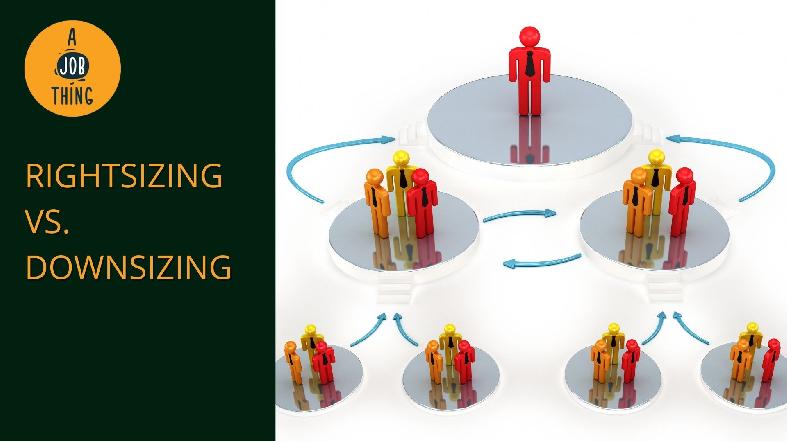
Rightsizing: Is It the Same as Downsizing?
Are You Hiring?
Find candidates in 72 Hours with 5+ million talents in Maukerja Malaysia & Ricebowl using Instant Job Ads.
HIRE NOW
The market could change at any time, and in today's world, that statement has never been more accurate. Some companies may need to let go of a few employees, hire new ones and shift others to another department to meet the organisation's goals. When a company does these actions, it is called rightsizing.
Rightsizing, not downsizing
Organisational rightsizing is not another word for downsizing, though one form of rightsizing could include employee dismissal, which would make it downsizing or retrenchment in the legal context.
Though rightsizing and downsizing are related and have some similarities, they are not the same in their overarching goals.
Downsizing involves decreasing the number of employees an organisation has to improve profitability and lessen redundancies.
Rightsizing is about getting the organisation to the right size for its new business objectives. Other than employee layoffs, a rightsizing organisation may also hire new employees with new skills and a higher level of expertise that the organisation needs.
One of its most important benefits is that rightsizing helps organisations to improve performance and reach goals.
The organisation may also switch specific employees to new positions to better use their functional expertise and in-house knowledge in other areas.
Rightsizing can also add a new management layer to enhance guidance and lessen vertical layers to better communication flow. Sometimes, rightsizing could result in larger departments increasing deliverable output.
The primary goal of rightsizing is to reorganise the company to better meet its latest strategic objectives. Different from downsizing, rightsizing is not a one-time event but a continuous activity that the organisation may be in for months or years.
Does your company need a rightsizing?
If you want to know whether your organisation needs a rightsizing or not, you should first review the organisation's goals. These are some helpful questions to figure out if you need a rightsizing:
- Is your company equipped with the right skills to meet the new goals?
- Have internal and external factors caused your organisation's objectives to change?
- How effectively is your organisation reach its goals?
Many organisations conduct an organisational audit to determine if they have the right roles and the right employees. It's crucial to align the human resources within the company to its strategic direction.
Rightsizing also involves looking at the future trends of your industry. The market changes might not be happening now, but if it seems that it will take a turn, an organisation must be prepared to manage the shift in direction.
.jpg)
Sometimes, a company needs to review and optimise its workforce, and it doesn't involve retrenchment.
Rightsizing case in Malaysia
There is a court case that considered a company's rightsizing exercise that resulted in several employees dismissed. In H'ng Siew Hoon v Thermo Fisher Scientific Malaysia Sdn Bhd [2020] 2 LNS 1590, the claimant filed an unfair dismissal claim alleging that her functions were not redundant. She said that her duties still existed but were transferred to another employee.
The company was undergoing a rightsizing exercise to bring its operations in line with the current demand. The company considered the claimant's role as surplus to its needs because of the workforce's sales efficiency and the financial performance in the market.
Due to the reduced sales in the market, the claimant's functions could be redistributed and absorbed by another senior manager handling more profitable markets.
The claimant also alleged that the company did not correctly apply the Last In First Out (LIFO) principle, as the senior manager had only joined the company ten months prior.
The court's decision
The court upheld the claimant's dismissal as it found a genuine redundancy had happened because there was a real need to reorganise the business. The decision to rightsize and retrench was based on the company's business performance, and they needed fewer employees.
The court further held that there was evidence to show the company's financial performance and that the Malaysian market achieved lower sales for four years compared to other Southeast Asian markets.
The court also found that the claimant's role was diminished because of the decline, and any other sales manager could absorb the shrunken functions.
Regarding the LIFO principle, the court held that it is illogical for the company to include the other senior sales managers managing other markets when the business that needs to be rightsized is Malaysia.
The claimant was the only one holding her position in Malaysia, and there was no reason to include other senior sales managers who handled other markets into consideration for LIFO.
The court stated there was no evidence to show that the rightsizing was made for a collateral purpose or bad faith.
In conclusion, rightsizing is a legitimate ground to dismiss employees, as long as there is an actual redundancy, and the company is not motivated by collateral purposes and bad faith.
Sources: Chron & Donovan & Ho
Articles that might interest you
First Employer Found Guilty Under Act 446 Fined RM20,000
Employers Who Violate Act on Worker Housing Can Be Fined Up To RM50k
Industrial Court Awards Ex-Manager RM800k for Unfair Dismissal





